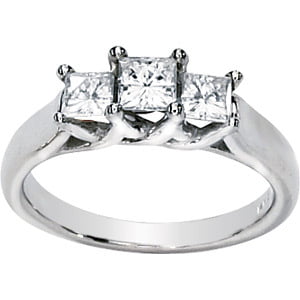Most happy young couples shopping for a diamond engagement ring are thinking about love, not war. But a recent movie starring Hollywood powerhouse Leonardo DiCaprio is drawing new attention to the debate on where diamonds come from and how to buy them responsibly.
The movie, called “Blood Diamond,” depicts the dirty world of conflict diamonds-rough diamonds that are used by rebel movements in parts of Africa to finance wars against legitimate governments.
In 1999, conflict diamonds made up about 4 percent of the international rough diamond output. These rough diamonds then found their way from cutting and shaping centers to diamond sellers and eventually into the hands of unwitting consumers. In response to a growing call to end illegal trading, the diamond industry collaborated with the United Nations, several international NGOs, and over 45 countries to create a certification process, called the Kimberly Process Certification Scheme (KPCS).
The KPCS is intended to guarantee that diamonds are conflict free, and was adopted by the U.N. in 2003. Today, 68 countries adhere to the KPCS, and the overall number of conflict diamonds has reportedly dropped to less than 1 percent.
Weak Links in the Chain
Despite the efforts of human rights organizations, the U.N., and the diamond industry, there are still major gaps in actually implementing the KPCS effectively.
According to the World Diamond Council, the U.S. buys more than 60 percent of the world’s rough diamonds. But the KPCS does not include a provision that requires diamond retail sellers to provide proof to the consumer that the diamonds are certified as conflict free. In fact, many sellers are less than happy to discuss their diamond purchasing policies.
Eleven phone calls to jewelers in New York, one of the world’s top diamond retail centers along with India and Israel, found mixed results. Aside from Tiffany’s (which could not be reached for comment), many retailers offered little or no reassurances. In fact, none of the stores contacted by The Epoch Times were willing to talk about their diamond buying policies, even when offered anonymous interviews.
“The industry itself has not made a wholesale change,” said Corinna Gilfillan, head of the U.S. office for the human rights organization Global Witness. If the industry was really committed to cleaning up its act, that would really help solve this problem. People in the industry are still willing to buy diamonds without asking where they came from.”
Even countries that are Kimberly Process certified present challenges to verifying the origin of the natural gems, known as rough diamonds.
“Ivory Coast is a major concern,” said Gilfillan in a telephone interview. “A recent U.N. Report showed that 22 million blood diamonds from Cote d’Ivoire [Ivory Coast] were being smuggled out into neighboring Ghana, which is a Kimberly Process country, where they were being certified as conflict free and exported out into major diamond markets like Belgium and Israel. It showed that the Kimberly Process is full of loopholes.”
Global Witness and Amnesty International have also been calling on the public to question the origins of the diamonds they purchase in light of undercover footage soon to be released by the U.K.-based companies Blood on the Stone Ltd. and Insight News TV. Camera crews visited Sierra Leone, Guinea, and other places in Africa that are KPCS member countries. They were able to easily evade Kimberly Process controls due to lack of internal governmental checks.
The documentary also includes undercover footage of diamond buyers in New York. Ten of the 11 dealers approached were willing to buy rough stones that lacked documentation proving they had gone through the Kimberly Process, or were said to come from Congo or the Ivory Coast.
Gilfillan adds that even countries that are KPCS approved should be watched. Sierra Leone and Angola and other countries that were affected by conflict diamonds, these countries still have very weak controls over the diamond mining areas. From our point of view, these weak government controls are a real concern because rebel groups or terrorists or unscrupulous traders can use these diamonds.”
The Diamond Industry’s Response
The diamond industry has been a major player in cleaning up the image of diamonds as a product linked to death and destruction, from participating in the Kimberly Process to informing the public about conflict diamonds and their industry’s role in their purchase and sale.
“The industry does not want our product, which is supposed to be associated with love and marking the emotional moments in people’s lives, to be associated with any negative activity in any part of the world,” said Cecilia Gardner, General Counsel of the World Diamond Council.
Part of this effort has included a major informational campaign, including launching a public relations Web site called www.diamondfacts.org, in mid 2006.
According to Gardner, even the industry knows and admits that there are holes in the process that need to, and are, being dealt with.
“The Kimberly Process [recently] sent a review team to deal with recent allegations that were brought to our attention by a U.N. review panel about the Ivory Coast,” said Gardner. The team included authorities from various governments and a team of diamond experts from the World Diamond Council.
Gardner said the team investigated whether Ghana is receiving smuggled Ivory Coast diamonds and claiming that they are from Ghana. The scrutiny has led authorities in the country to agree to a specific and time-sensitive action plan to determine what is happening within their borders and how to take steps to improve internal control over their diamond industry.
Other countries, including Liberia, who claim they have cleaned up their act in regard to conflict diamonds, are waiting for U.N. sanctions to be lifted so they can apply to be recognized as a KPCS certified country.
Renewed and Continuing Efforts
The recent annual Kimberly Process Plenary Meeting last month in Botswana focused on a call for renewed efforts to strengthen the KPCS and make it more effective. This included making public data about the movement of rough diamonds. The data is not yet available, but was approved for public release during the meetings.
Human rights groups Amnesty International and Global Witness are urging the U.S. government to strengthen and enforce the Clean Diamond Trade Act. A renewed debate on conflict diamonds is being raised in mainstream society, thanks in great part to the release of DiCaprio’s movie.
However, until loopholes in the Kimberly Process are closed and tighter restrictions can be made for countries like the U.S., the end responsibility lies with the consumer.
Anti-conflict diamond advocates advise that consumers can simply ask their diamond retailers if the stones they are buying have been certified as conflict free, or if they went through the Kimberly Process. The process includes a monitoring, tracking, and inspection system that is meant to guarantee the stones are conflict free from source of origin until they reach the seller’s case in the jewelry store.
Additional reporting by Chris McVicar and Aaron Nelson



